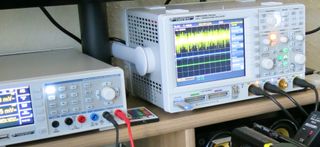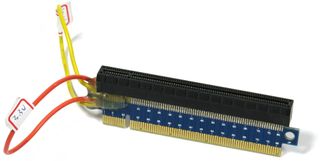Radeon R9 295X2 8 GB Review: Project Hydra Gets Liquid Cooling
“Do you have what it takes?” AMD asks, purportedly referring to the big budget and beefy power supply you need before buying its new Radeon R9 295X2. We benchmark the 500 W, dual-GPU beast against several other high-end configs before declaring a winner.
Power Consumption: Introducing Our Equipment
Three Generations Of AMD Dual-GPU Cards, Compared
Naturally, we're going to compare the power consumption of AMD's Radeon R9 295X2 to other CrossFire- and SLI-based setups. But first, we want to use our high-end equipment for a little experiment, comparing the company's newest dual-GPU card to its predecessors. The point is to figure out whether AMD is moving in the right direction with its flagship cards.

Meet Our Test Equipment
Our power consumption test setup was planned in cooperation with HAMEG (Rohde & Schwarz) to yield accurate measurements at small sampling intervals, and we've improved the gear continuously over the past few months.

AMD’s PowerTune and Nvidia’s GPU Boost technologies introduce significant changes to loading, requiring professional measurement and testing technology if you want accurate results. With this in mind, we're complementing our regular numbers with a series of benchmarks using an extraordinarily short range of 100 μs, with a 1 μs sampling rate.
We get this accuracy from a 500 MHz digital storage oscilloscope (HAMEG HMO 3054), while measuring currents and voltages with the convenience of a remote control.

The measurements are captured by three high-resolution current probes (HAMEG HZ050), not only through a riser card for the 3.3 and 12 V rails (which was custom-built to fit our needs, supports PCIe 3.0, and offers short signal paths), but also directly from specially-modified auxiliary power cables.

Voltages are measured from a power supply with a single +12 V rail. We're using a two-millisecond resolution for the standard readings, which is granular enough to reflect changes from PowerTune and GPU Boost. Because this yields so much raw data, though, we keep the range limited to two minutes per chart.
| Methodology | Contact-free DC measurement at PCIe slot (using a riser card)Contact-free DC measurement at external auxiliary power supply cableVvoltage measurement at power supply |
|---|---|
| Test Equipment | 1 x HAMEG HMO 3054, 500 MHz digital multi-channel oscilloscope 3 x HAMEG HZO50 current probes (1 mA - 30 A, 100 kHz, DC) 4 x HAMEG HZ355 (10:1 probes, 500 MHz) 1 x HAMEG HMC 8012 digital multimeter with storage function |
| Power Supply | Corsair AX860i with modified outputs (taps) |
Stay on the Cutting Edge
Join the experts who read Tom's Hardware for the inside track on enthusiast PC tech news — and have for over 25 years. We'll send breaking news and in-depth reviews of CPUs, GPUs, AI, maker hardware and more straight to your inbox.
Current page: Power Consumption: Introducing Our Equipment
Prev Page Results: Tomb Raider Next Page Power Consumption: Idle-
Marsian Gustrianda Many people doubt about Dual GPU Hawaii will be Blow Up. It seems AMD really do well job. Nice Looking CardReply -
ohim This card is like the Veyron of WV , show the world what you can do (R295x2) but you`ll still relay on the sales of your WV Golf for revenue (270x, 280x)Reply -
outlw6669 Impressive performance, temperatures and fairly low noise!Reply
I would prefer a bit lower price, but this looks like a great card for the gamer that has everything! -
gunfighter zeck the name Dreadnaught originated from Dread Nothing or, fear nothing.Reply
Boss ship. -
Maxamus456 Hope this price stays low and not get bloated from bit con miners like its predecessors.Reply -
blubbey So let me get this straight. It runs pretty cool, quiet, performs well and (for the moment) is able to play a good selection of games at 4k admirably and is priced competitively. Plus if you are going to drop a bit more on watercooling your GPUs (which is a possibility if you're spending $1200+) that gives this card even greater value. Nice work AMD.Reply -
marciocattini Wheres Tom's Hardware seal of approval? =( clearly this card diserves some love!Reply
Most Popular

